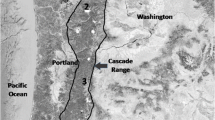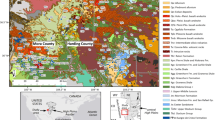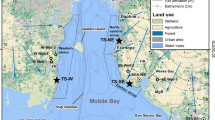Abstract
We studied sediment cores from four Florida (USA) lakes that have received groundwater hydrologic supplements (augmentation) for >30 years to maintain lake stage. Top samples (0–4 cm) from sediment cores taken in Lakes Charles, Saddleback, Little Hobbs, and Crystal had 226Ra activities of 44.9, 17.5, 7.6, and 8.5 dpm g−1, respectively, about an order of magnitude greater than values in deeper, older deposits. The surface sample from Lake Charles yielded the highest 226Ra activity yet reported from a Florida lake core. Several lines of evidence suggest that groundwater augmentation is responsible for the high 226Ra activities in recent sediments: (1) 226Ra activity in cores increased recently, (2) the Charles, Crystal, and Saddleback cores display 226Ra/210Pb disequilibrium at several shallow depths, suggesting 226Ra entered the lakes in dissolved form, (3) cores show recent increases in Ca, which, like 226Ra, is abundant in augmentation groundwater, and (4) greater Sr concentrations are associated with higher 226Ra activities in recent Charles and Saddleback sediments. Sr concentrations in Eocene limestones of the deep Floridan Aquifer are high relative to Sr concentrations in surficial quartz sands around the lakes. Historical water quality inferences for the lakes were based on diatom assemblages in sediments. Recent alkalization in Lakes Charles, Saddleback, Little Hobbs, and Crystal was inferred from weighted-averaging calibration (WACALIB). The lakes also show recent trophic state increases based on WACALIB-derived estimates for limnetic total P. Although residential and agricultural sources might contribute to increased P loading, P in augmentation waters probably has had significant influence on eutrophication. Dystrophic diatoms were abundant in the early history of Lakes Saddleback, Little Hobbs, and Crystal, which suggests that these lakes contained more tannic waters during the past than at present, perhaps as a consequence of greater inflows from surrounding wetlands. Ionic content of lake waters increased, as indicated by diatom autecological analysis. Recent geochemical and biological changes detected in cores from these lakes probably are a result of deliberate groundwater augmentation, although inputs of groundwater pumped for agricultural and residential development in the watersheds also might have contributed to limnological changes.
Similar content being viewed by others
References
Andersen JM (1976) An ignition method for determination of total phosphorus in lake sediments. Water Res 10:329–331
Brenner M, Keenan L, Miller SJ, Schelske CL (1999) Spatial and temporal patterns of sediment and nutrient accumulation in shallow lakes of the upper St. Johns River Basin, Florida. Wetlands Ecol and Manage 6:221–240
Brenner M, Peplow AJ, Schelske CL (1994) Disequilibrium between 226Ra and supported 210Pb in a sediment core from a shallow Florida lake. Limnol Oceanogr 39:1222–1227
Brenner M, Schelske CL, Whitmore TJ (1997) Radium-226 stratigraphy in Florida lake sediments as an indicator of human disturbance. Verh Internat Verein Limnol 26:809–813
Brenner M, Schelske CL, Keenan LW (2001) Historical rates of sediment and nutrient accumulation in marshes of the Upper St. Johns River Basin, Florida, USA. J Paleolimnol 26:241–257
Brenner M, Schelske CL, Kenney WF (2004) Inputs of dissolved and particulate 226Ra to lakes and implications for 210Pb dating recent sediments. J Paleolimnol 32:53–66
Brenner M, Smoak JM, Allen MS, Schelske CL, Leeper DA (2000) Biological accumulation of 226Ra in a groundwater-augmented Florida lake. Limnol Oceanogr 45:710–715
Brenner M, Whitmore TJ (1999) Paleolimnological reconstruction of water quality for Lakes Dosson, Halfmoon and Round in Hillsborough County, Florida. Final Report to the Southwest Florida Water Management District, Brooksville, FL, 158 pp
DeArmond BS, Brenner M, Kenney WF, Leeper DA, Smoak JM, Curtis JH, Shumate BC, Buck DG, in press. Radium-226 accumulation in sediments of a groundwater-augmented lake near Tampa, Florida, USA. Verh. Internat. Verein. Limnol
Deevey ES (1988) Estimation of downward leakage from Florida lakes. Limnol Oceanogr 33:1308–1320
Dooris PM, Martin DF (1979) Ground-water induced changes in lake chemistry. Ground Water 17:324–327
Dooris PM, Dooris GM, Martin DF (1982) Phytoplankton responses to ground water addition in central Florida lakes. Water Res Bull 18:335–337
Fanning KA, Breland JA II, Byrne RH (1982) Radium-226 and radon-222 in the coastal waters of west Florida: high concentrations and atmospheric degassing. Science 215:667–670
Fisher MM, Brenner M, Reddy KR (1992) A simple, inexpensive piston corer for collecting undisturbed sediment/water interface profiles. J Paleolimnol 7:157–161
Florida Lakewatch (1999) Florida Lakewatch Data 1986–1999. Dept. of Fisheries and Aquatic Sciences. University of Florida, Gainesville, FL
Gasse F, Fontes JC, Plaziat JC, Carbonel P, Kaczmarska I, De Deckker P, Souliê-Marsche I, Callot Y, DuPeuble PA (1987) Biological remains, geochemistry and stable isotopes for the reconstruction of environmental and hydrological changes in the Holocene lakes from North Sahara. Palaeogeog Palaeoclimatol Palaeoecol 60:1–46
Håkanson L, Jansson M (1983) Principles of lake sedimentology. Springer-Verlag, New York, 316 pp
Harada K, Burnett WC, Larock PA, Cowart JB (1989) Polonium in Florida groundwater and its possible relationship to the sulfur cycle and bacteria. Geochim Cosmochim Acta 53:143–150
Hazardous Substance and Waste Management Research, Inc. (2000) Human health risk assessment and preliminary ecological evaluation regarding potential exposure to Radium-226 in several central Florida lakes ecosystems. Report to the Southwest Florida Water Management District, Brooksville, FL, 21 pp. + appendices
Hazardous Substance and Waste Management Research, Inc. (2004) Human health risk assessment regarding potential exposure to Radium-226 in two central Florida lake systems. Report to the Southwest Florida Water Management District, Brooksville, FL, 15 pp. + appendices
Hustedt F (1930) Die süsswasser flora Mitteleuropas. Heft 10. Bacillariophyta (Diatomeae). Jena. Gustav Fischer, 466 pp
Kaufmann RF, Bliss JD (1977) Effects of phosphate mineralization and the phosphate industry on radium-226 in ground water of central Florida. U.S. Environmental Protection Agency Final Report EPA/520-6-77-010. EPA Office of Radiation Programs, Las Vegas, NV
Krammer K, Lange-Bertalot H (1986–1991) Bacillariophyceae, Teil 1–4. In A. Pascher, Süsswasserflora von Mitteleuropa. Gustav Fischer Verlag, Jena
Krishnaswami S, Lal D (1978) Radionuclide limnochronology. In: Lerman A (ed) Lakes: chemistry, geology, physics. Springer-Verlag, New York, pp 153–177
Line JM, ter Braak CF, Birks HJ (1994) WACALIB version 3.3: a computer program to reconstruct environmental variables from fossil assemblages by weighted averaging and to derive sample-specific errors of prediction. J Paleolimnol 10:147–152
Lowe RL (1974) Environmental requirements and pollution tolerance of freshwater diatoms. U.S. Environmental Protection Agency Report EPA-670/4-74-005, National Environmental Research Center, Cincinnati, OH, 334 pp
Martin DF, Victor DM, Dooris PM (1976a). Effects of artificially introduced ground water on the chemical and biochemical characteristics of six Hillsborough County (Florida) lakes. Water Res 10:65–69
Martin DF, Victor DM, Dooris PM (1976b) Implications of lake augmentation on growth of Hydrilla. J Environ Sci Health 3:245–253
Metz PA, Sacks LA (2002) Comparison of the hydrogeology and water quality of a ground-water augmented lake with two non-augmented lakes in northwest Hillsborough County, Florida. U.S. Geological Survey Water Resources Investigation Report 02-4032. Tallahassee, FL, 74 pp
Miller RL, Kraemer TF, McPherson BF (1990) Radium and radon in Charlotte Harbor Estuary, Florida. Estuarine, Coastal Shelf Sci 31:439–457
Moore WS (1984) Radium isotope measurements using germanium detectors. Nucl Inst Methods 223:407–411
Patrick R, Reimer CW (1966–1975) The diatoms of the United States. Monographs of the Academy of Sciences of Philadelphia No. 13, Part 1, vols. 1–2
Reed JM (1998) A diatom-conductivity transfer function for Spanish salt lakes. J Paleolimnol 19:399–416
Riedinger-Whitmore MA, Whitmore TJ, Brenner M, Moore AM, Smoak J, Curtis JH, Schelske CL (2005) Cyanobacterial proliferation is a recent response to eutrophication in many Florida lakes: a paleolimnological assessment. Lake Reserv Manage 21:423–435
Schelske CL, Conley DJ, Stoermer EF, Newberry TL, Campbell CD (1986) Biogenic silica and phosphorus accumulation in sediments as indices of eutrophication in the Laurentian Great Lakes. Hydrobiologia 143:79–86
Schelske CL, Peplow A, Brenner M, Spencer CN (1994) Low-background gamma counting: applications for 210Pb dating of sediments. J Paleolimnol 10:115–128
Stewart JW, Hughes GH (1974) Hydrologic consequences of using ground water to maintain lake levels affected by water wells near Tampa, Florida. USGS Survey Report of Investigations No. 74. Florida Department of Natural Resource, Tallahassee, FL, 41 pp
Upchurch SB, Randazzo AF (1997) Environmental geology of Florida. In: Randazzo AF, Jones DS (eds) The geology of Florida. University Press of Florida, Gainesville FL, pp 217–249
Van Dam H, Mertens A, Sinkeldam J (1994) A coded checklist and ecological indicator values of freshwater diatoms from the Netherlands. Netherlands J Aquat Ecol 28:117–133
Van der Werff A (1955) A new method of concentrating and cleaning diatoms and other organisms. Int Ver Theor Angew Limnol Verh 12:276–277
Whitmore TJ (1989) Florida diatom assemblages as indicators of trophic state and pH. Limnol Oceanogr 34:882–895
Whitmore TJ, Brenner M, Curtis JH, Dahlin BH, Leyden BW (1996) Holocene climatic and human influences on lakes of the Yucatan Peninsula, Mexico: an interdisciplinary, palaeolimnological approach. The Holocene 6:273–287
Acknowledgements
Funding was provided by the Coastal Rivers, Hillsborough River, and Northwest Hillsborough Basin Boards of the Southwest Florida Water Management District. Interpretations and conclusions are not necessarily those of the supporting agency. Adam Munson and Jaime Escobar assisted with core collection. Cory Catts, Luciana Spatazza, and Nia Thommi helped with laboratory analyses. Atte Korhola and an anonymous reviewer provided helpful comments on the manuscript. This is a publication of the University of Florida Land Use and Environmental Change Institute.
Author information
Authors and Affiliations
Corresponding author
Rights and permissions
About this article
Cite this article
Brenner, M., Whitmore, T.J., Riedinger-Whitmore, M.A. et al. Geochemical and biological consequences of groundwater augmentation in lakes of west-central Florida (USA). J Paleolimnol 36, 371–383 (2006). https://doi.org/10.1007/s10933-006-9008-7
Received:
Accepted:
Published:
Issue Date:
DOI: https://doi.org/10.1007/s10933-006-9008-7




